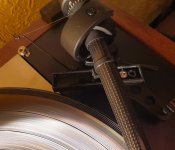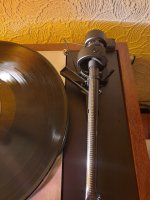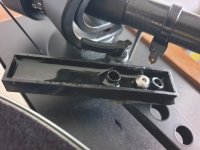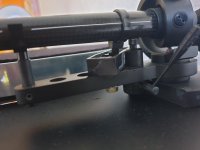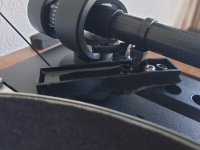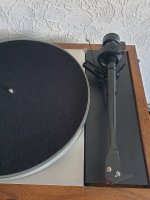I have read lots of comments on this cartridge but can find nothing relating to this tonearm.
I'd like to try the cartridge but have no idea if it will be a dud on this arm.
Folk say the cart likes a stiff arm which this should be.
They say it likes damping and I have a trough fitted
But then I read the cart likes a heavy arm which mine is not or whether the bearings are the wrong type.
Turntable is a heavily modded Linn LP12.
Mober one piece sub chassis, DC motor etc etc.
Anyone tried similar?
Thanks Rob.
I'd like to try the cartridge but have no idea if it will be a dud on this arm.
Folk say the cart likes a stiff arm which this should be.
They say it likes damping and I have a trough fitted
But then I read the cart likes a heavy arm which mine is not or whether the bearings are the wrong type.
Turntable is a heavily modded Linn LP12.
Mober one piece sub chassis, DC motor etc etc.
Anyone tried similar?
Thanks Rob.
Sorry, can’t help with the Decca, but I am interested to know which damping through you use. Is it the one made by Oracle?
@Al2002
I looked at the Oracle one but here in the UK it seemed expensive and not easy to get hold of.
Instead I used a black Lego brick 10x2. Free from kids box 🙂
Turned upside down. Drilled a hole through one of the far central tubes and fitted a small stainless bolt with a penny washer at the bottom. Cut out the unrequired inner parts of the brick with a pair of snips and smoothed
with a mini rotary tool.
This mounts then in the same way the Oracle trough does.
Left the last cross section in place to reduce the amount of silicone fluid needed. I did cut off the top round sections just where it sits on the 9CC. Then blocked the holes that left with glue to make a 'drip tray' in the parked position although little if any fluid drips off the damper paddle.
Tried a couple of DIY paddles but found a black zip tie worked very well. Cut the tail off at the correct length in a V to create the paddle. Pulled tight enough that it can just about be twisted around if adjustment needed.
Put 100,000 Silicone oil in the bath and settled on about 2-3mm of paddle in.
Total cost about an hour of effort and £5 (fluid was a large bottle from ebay used for RC cars)
I currently use a Sure V15 mxr cartridge.
With its build in damper brush down I had a defined sound but slightly reduced sound stage and air.
With damper up I had better sound stage but not quite as defined space around instruments and tad of harshness in the treble with say Jazz type instruments.
With the DIY damper I now have the best of both with the brush up so it has been a win for me. I feel it is therefore doing what it is supposed to for next to no cost. As daft as this solution sounds, it does not look out of place on the TT.
I looked at the Oracle one but here in the UK it seemed expensive and not easy to get hold of.
Instead I used a black Lego brick 10x2. Free from kids box 🙂
Turned upside down. Drilled a hole through one of the far central tubes and fitted a small stainless bolt with a penny washer at the bottom. Cut out the unrequired inner parts of the brick with a pair of snips and smoothed
with a mini rotary tool.
This mounts then in the same way the Oracle trough does.
Left the last cross section in place to reduce the amount of silicone fluid needed. I did cut off the top round sections just where it sits on the 9CC. Then blocked the holes that left with glue to make a 'drip tray' in the parked position although little if any fluid drips off the damper paddle.
Tried a couple of DIY paddles but found a black zip tie worked very well. Cut the tail off at the correct length in a V to create the paddle. Pulled tight enough that it can just about be twisted around if adjustment needed.
Put 100,000 Silicone oil in the bath and settled on about 2-3mm of paddle in.
Total cost about an hour of effort and £5 (fluid was a large bottle from ebay used for RC cars)
I currently use a Sure V15 mxr cartridge.
With its build in damper brush down I had a defined sound but slightly reduced sound stage and air.
With damper up I had better sound stage but not quite as defined space around instruments and tad of harshness in the treble with say Jazz type instruments.
With the DIY damper I now have the best of both with the brush up so it has been a win for me. I feel it is therefore doing what it is supposed to for next to no cost. As daft as this solution sounds, it does not look out of place on the TT.
Hi, Your arm is a super low Eff Mass of 8 grams. the London has a compliance of 12 x 10-6cm/Dyne. So it would be unwise to use them together. The London really requires a Medium/Heavy arm with an Eff mass of around 18 - 20 to work at it's best.
Also you are falling into the trap of thinking to upgrade the cartridge to a super model before upgrading your tonearm.
Cheers
Also you are falling into the trap of thinking to upgrade the cartridge to a super model before upgrading your tonearm.
Cheers
Also you are falling into the trap of thinking to upgrade the cartridge to a super model before upgrading your tonearm.
Ding!
jeff
Those of us with grey hair - and plenty of it - remember vividly a time when 5-6 g effective mass was considered low and 8-10 g was considered medium. No way can 8-10 g be considered super low effective mass, even by today’s standards.
The 9CC arm was tested by Hi Fi News and the measured effective arm mass was 10g.
Re. the Decca cartridge, it was originally a mono cartridge with very low vertical compliance, so I’m not sure the figure mentioned is correct. However, for purposes of calculation let’s say it is correct
The arm’s mass is 10 g, 7 g for the cartridge. Add, say, a couple of g for screws, washers, etc and it comes to 19 g. Round it off to 20 g total. With a compliance of 12 E-6 cm/ dyne, that gives a resonant frequency of just a bit over 10 Hz which is perfectly fine, 12-15 Hz being optimum, 10 Hz being OK. Not sure why you’ve suggested a tone arm effective mass of ca. 20 g. That would put the resonant frequency around 8 Hz, which is quite undesirable.
It’s also not clear why you refer to the Decca as a super cartridge. I owned a Gold - not super gold - briefly 35-40 years ago and it was awful. Bright, miserable tracking, always had me on the edge of my seat. Sibilants, strings and the like were unbearable. Couldn’t wait to get rid of it. Unless a miraculous transformation has occurred in the design and manufacturing of this cartridge since then, I’d urge caution.
Lastly, the 9CC is a very fine arm with fluid damping if the tests are to be believed, so what aspect of its performance makes you think it needs upgrading?
The 9CC arm was tested by Hi Fi News and the measured effective arm mass was 10g.
Re. the Decca cartridge, it was originally a mono cartridge with very low vertical compliance, so I’m not sure the figure mentioned is correct. However, for purposes of calculation let’s say it is correct
The arm’s mass is 10 g, 7 g for the cartridge. Add, say, a couple of g for screws, washers, etc and it comes to 19 g. Round it off to 20 g total. With a compliance of 12 E-6 cm/ dyne, that gives a resonant frequency of just a bit over 10 Hz which is perfectly fine, 12-15 Hz being optimum, 10 Hz being OK. Not sure why you’ve suggested a tone arm effective mass of ca. 20 g. That would put the resonant frequency around 8 Hz, which is quite undesirable.
It’s also not clear why you refer to the Decca as a super cartridge. I owned a Gold - not super gold - briefly 35-40 years ago and it was awful. Bright, miserable tracking, always had me on the edge of my seat. Sibilants, strings and the like were unbearable. Couldn’t wait to get rid of it. Unless a miraculous transformation has occurred in the design and manufacturing of this cartridge since then, I’d urge caution.
Lastly, the 9CC is a very fine arm with fluid damping if the tests are to be believed, so what aspect of its performance makes you think it needs upgrading?
Hi, Your arm is a super low Eff Mass of 8 grams. the London has a compliance of 12 x 10-6cm/Dyne. So it would be unwise to use them together. The London really requires a Medium/Heavy arm with an Eff mass of around 18 - 20 to work at it's best.
Also you are falling into the trap of thinking to upgrade the cartridge to a super model before upgrading your tonearm.
Cheers
Last edited:
Brilliant, just Brilliant.
Would you mind posting a couple of side view photos showing the mounting arrangement.
Would you mind posting a couple of side view photos showing the mounting arrangement.
A picture, looks better by eye than camera.
Ok, a few minutes on google turned up this:
London (Decca) Jubilee/Reference phono cartridge Measurements | Stereophile.com
Not sure how close this is to a current production Decca, but the comments on tracking, or lack of it, pretty much mirror my own experience.
London (Decca) Jubilee/Reference phono cartridge Measurements | Stereophile.com
Not sure how close this is to a current production Decca, but the comments on tracking, or lack of it, pretty much mirror my own experience.
Last edited:
Just googled Decca Super Gold, can’t believe how expensive it is.
Rob, have you considered the Goldring Ethos? See the MPP thread, starting here:
https://www.diyaudio.com/forums/analogue-source/154210-mpp-234.html#post6848057
Rob, have you considered the Goldring Ethos? See the MPP thread, starting here:
https://www.diyaudio.com/forums/analogue-source/154210-mpp-234.html#post6848057
I will post a few more pics of the diy damper this evening.
From my research the London super gold is better than the original in terms of quality. The comments about its sound interest me. Some rate them very highly despite the caveats.
Some say its tricky to set up to track well but others swear its fine.
Arm compatibility is the question. The 9cc may not be high end but its not a bad performer.
It appears going by compliance is not purely the key element on whether they will work well together, the London decca being an unusual thing.
My Shure V15 mxr is the best cartridge I own out of half a dozen. It has an original low hours stylus.
I am at that point where another £1k could be a step forward, sideways or backwards.
Changing both the arm and cartridge could get costly.
From my research the London super gold is better than the original in terms of quality. The comments about its sound interest me. Some rate them very highly despite the caveats.
Some say its tricky to set up to track well but others swear its fine.
Arm compatibility is the question. The 9cc may not be high end but its not a bad performer.
It appears going by compliance is not purely the key element on whether they will work well together, the London decca being an unusual thing.
My Shure V15 mxr is the best cartridge I own out of half a dozen. It has an original low hours stylus.
I am at that point where another £1k could be a step forward, sideways or backwards.
Changing both the arm and cartridge could get costly.
Looks like the Ethos has a typical MC output and I am running a tube phono pre amp that requires closer to MM levels. Otherwise I'd need to enter into step up transformers.Just googled Decca Super Gold, can’t believe how expensive it is.
Rob, have you considered the Goldring Ethos? See the MPP thread, starting here:
https://www.diyaudio.com/forums/analogue-source/154210-mpp-234.html#post6848057
More pics of the diy damper as requested.
Ignore the black tape, that can come off now. I put it on while the glue dried that i used to block the holes created after cutting off the 5 or so raised dots.
Ignore the black tape, that can come off now. I put it on while the glue dried that i used to block the holes created after cutting off the 5 or so raised dots.
Attachments
Update on this idea.
I have looked at arms that would be more likely to work with a Decca super gold.
The Hadcock 228 (current production) was one that got repeated a few times.
Options limited as my Linn has a single piece alloy sub chassis - no cutting arm boards.
Came across a Alphason HR100 mcs which should be a direct install and while not a unipivot has been mentioned as coping with a Decca.
On paper not a good match for my Shure or MMC20CL but I will install it when arrives to get an idea of its signature.
There would be other cartridges that arm could open options for but I have no low level input unless I picked up a Suitable SUT. Rob
I have looked at arms that would be more likely to work with a Decca super gold.
The Hadcock 228 (current production) was one that got repeated a few times.
Options limited as my Linn has a single piece alloy sub chassis - no cutting arm boards.
Came across a Alphason HR100 mcs which should be a direct install and while not a unipivot has been mentioned as coping with a Decca.
On paper not a good match for my Shure or MMC20CL but I will install it when arrives to get an idea of its signature.
There would be other cartridges that arm could open options for but I have no low level input unless I picked up a Suitable SUT. Rob
Sorry mate, you are barking up the wrong tree. As advised before Low Eff mass arm will not work with the Decca. the Hadcock is also a Low Eff Mass. You need an arm with an Eff mass of at least 18 grams.
check the out to learn more and look at what happens with the 103 when used with a LEM arm.
https://www.google.com/url?sa=t&rct...m/calculator&usg=AOvVaw3TZBwCCUJnkZylN5_xdzus
CHEERS
check the out to learn more and look at what happens with the 103 when used with a LEM arm.
https://www.google.com/url?sa=t&rct...m/calculator&usg=AOvVaw3TZBwCCUJnkZylN5_xdzus
CHEERS
- Home
- Source & Line
- Analogue Source
- London Decca Super Gold on a Project 9cc ?
